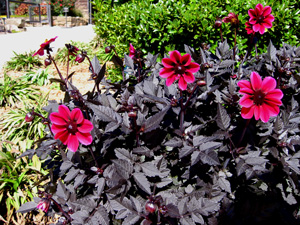Resource Library
Plant of the Week: Dahlia, Black Leafed Hybrids
The University of Arkansas System Division of Agriculture does not promote, support or recommend plants featured in "Plant of the Week." Please consult your local Extension office for plants suitable for your region.
Plant of the Week
Dahlia Black Leafed Hybrids

The ebb and flow of plants in the garden world is nonstop with some plants gaining popularity while others disappear into the void, only to return as a new generation of gardeners discover them. Forty years ago as I drove the back roads of Arkansas I used to see some large dahlia plantings, but today I would be hard pressed to even find a single plant. However, that could change as a new wave of black leafed dahlias becomes better known.
Dahlias are herbaceous perennials of the daisy family native to the mountains of Mexico and Central America. They were cultivated by the Aztecs during the time of the Spanish conquest (1519-1524) but were not introduced into Europe until 1789. There are about 27 species of dahlias known with most of the garden hybrids derived from crosses between Dahlia coccinea and D. pinnata.
In nature dahlias are large, frost-tender herbaceous plants growing 6 to 20 feet tall with fleshy tuberous roots. When first introduced to Europe they were touted as a new food crop to compete with potatoes but it was soon discovered the tubers were “edible but not agreeable” and even rejected by livestock.
By the 1830s, dahlias were one of the most fashionable plants in European gardens and several hundred cultivars were available during this period. By the 1880s, they had gained their own plant society and new momentum when the large cactus flowered types began to appear. Over the past two centuries, more than 50,000 cultivars have been named.
The large traditional dahlias are a hands-on kind of garden flower. To keep them looking well they must be tended, fussed with and cultivated. The large types require staking and pruning to keep them looking their best and a considerable amount of room in the garden. At the end of the growing season the tubers must be dug and stored over winter in a frost free area. This commitment of time and energy in today’s busy world has cut into the popularity of the plants.
Attempts at remaking the image of the dahlia as a foot-tall bedding plant that is grown from seed have been ongoing over the past five decades, but has never really caught on with the gardening public. Newer attempts to introduce selections with an intermediate form for use in containers and mixed into the garden border may be more promising.
Black-leafed selections add color and contrast to the garden even when plants are not in flower. Verwer Dahlias, a Dutch company established in 1967 near Haarlem, Netherlands, has taken the lead in developing many new dahlia clones including the black leafed Dark Angel series that average around two feet tall with 3-inch single or anemone type flowers in shades of pink and red.
Dahlias need full sun, a rich garden soil and attention to watering needs during the summer months. They do best in areas with bright, warm days and cool nights where they will flower during the summer and fall. Most of the modern cultivars are considered ever-blooming but in hot climates the blooms will be more concentrated during the latter part of the summer and fall when night temperatures have begun to drop. Deadheading and pinching is required to keep the plants full and floriferous. Tubers should be lifted after the first light frost and stored in dry peat moss in a well ventilated, frost-free area.
By: Gerald Klingaman, retired
Retired Extension Horticulturist - Ornamentals
Extension News - October 19, 2012
The University of Arkansas System Division of Agriculture does not maintain lists of retail outlets where these plants can be purchased. Please check your local nursery or other retail outlets to ask about the availability of these plants for your growing area.